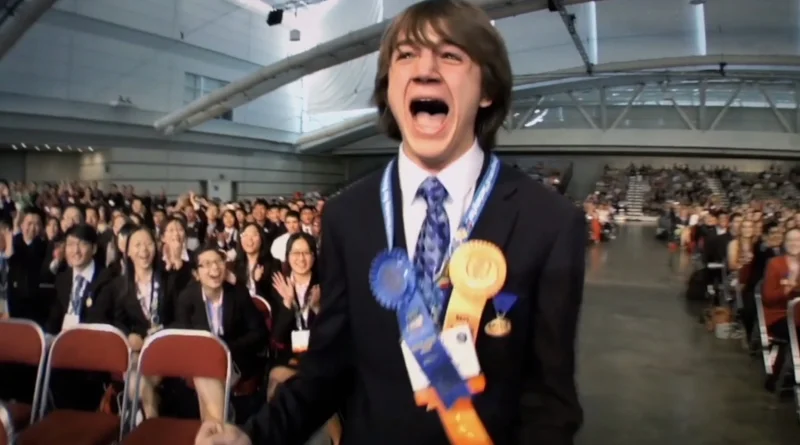SCIENCE FAIR
Directing: A
Writing: A-
Cinematography: B+
Editing: A
I found Science Fair to be deeply, deeply affecting — in a profoundly positive way. How often does a documentary make you cry tears of joy? Maybe I’ve just become a sap, but this film was such a joy to watch, it worked as an antidote to the exhausting defiance in the face of despair that fueled the making of Michael Moore’s Fahrenheit 11/9.
That other film is plenty worthy in its own right, mind you. It even offers plenty of hope, showcasing individuals and organizations working to make positive change on the political landscape. The key difference here is those people are pushing back, against truly dark forces. Science Fair, by contrast, is like the thinking-man’s escapism, with a purity not found anywhere else — of youth, of intent, of research and data. Nothing here is corrupted in any way.
Okay, so there’s a young Muslim woman at a high school in South Dakota headed to the International Science and Engineering Fair (ISEF), whose own science teachers have no interest in supporting her, who finds the unlikeliest of champions in the school’s football coach, of all people — and whose stunning scientific achievements on a national stage do not get the slightest official recognition by her school. This is of course, awful, and mentioned in passing, but guess what that kid is doing now? Attending school at Harvard. Fuck you, South Dakota!
This is one of very, very few negative details of any kid’s story showcased in Science Fair, and it barely gets notice. It’s far more important, and significant, that young Kashfia found a widely recognized practical application for her brilliance, and that she did so with the support of her Muslim parents raising her in a deep red state.
With 1700 students from around the world competing at ISEF, in this film presented in 2017 in Los Angeles, surely plenty of them aren’t the most telegenic, or the most charming, or the most articulate kids in the world — but Science Fair doesn’t bother with them. I always wonder about how much footage gets shot in films like these, how they choose to find the subjects they will follow around with cameras from rather early on in whatever tournament it is. In this case, although most of the kids do come from the U.S. — nine projects qualify for ISEF from one Long Island high school alone — there are also kids featured in several other countries doing extraordinary things. A young woman researching the cure for the Zika virus in the poor Brazilian region where it originated. A young German man who re-engineered the 100-year-old plane design and cut its fuel consumption by a third.
Even a lot of the American kids come from surprisingly rural areas, such as the kid from West Virginia who designed an AI program that generated rap lyrics modeled on the style of Kanye West (not to mention Kashfia, from South Dakota). One person in the film somewhat pointedly mentions that smart people come from rural areas too.
The common quality among all of them is how they give meaning to the phrase “best and brightest.” It’s awe-inspiring to look upon these kids, on average incredibly well behave and disciplined, because how else could they take part in a competition like this? They are, to a person, a joy to watch onscreen. In most cases they are outright adorable. One would be hard pressed to find anything else to offer so much hope for the future, with this mass of kids who will clearly be changing the world we live in tomorrow, in many cases literally revolutionizing the future. These kids have emotional investment in making the world a better place, a passion that is infectious. I honestly could not get enough of it.
Consider the countless kids who don’t win any of the top awards, or place at all (several of the kids the cameras follow, in fact, don’t win anything at ISEF). They are an entire community of world-changers. That would include plenty of the kids who competed in statewide and regional science fairs who didn’t even make it this far.
Co-directors Cristina Costantini and Darren Foster do take a brief moment to interject a clear agenda, there near the end of the film. At least two teachers interviewed lament how the United States is “becoming anti-science.” In the context of Science Fair in its entirety, though, that feels less like a statement of hard fact than of caution. They take care to note how many scientific breakthroughs made in America were made by people not American-born. But if these kids are the inventors of our future, at least for now, scientific breakthroughs will for some time come from immigrants thrilled to be here.
I suppose with any audience bothering to see this movie, it’s preaching to the choir. Except almost none of it is preaching, and even the choir can use a pep talk from time to time. The stories showcased here are overwhelmingly hopeful, and that’s precisely what we all need to be seeing. Science Fair is charming beyond measure, from its opening footage of 15-year-old Jack Andraka going nuts with excitement after winning the top prize at ISEF in 2012 (and being interviewed now as a 20-year-old with just as much rousing energy), to the closing montage of where these subjects went after the 2017 competition. A 14-year-old girl with stunning self-confidence working to prevent cancer by detecting arsenic levels in water supplies is just one thread of many, the tip of the iceberg. I left Science Fair having my well-worn cynicism cracked open, riding a wave of optimism, however cautious it may be.
Science as the feel-good movie of the year: enthusiasm for all the right things.
Overall: A-

